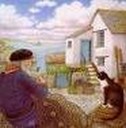Language Therapy Inference
 Language Therapy Inference: This webpage provides you with a typical language intervention
session with an 10 year old girl with language difficulty.
Language Therapy Inference: This webpage provides you with a typical language intervention
session with an 10 year old girl with language difficulty.
The language domain the clinician
has targeted for this session is inference skill.
Inference skills are a critically important part of reading comprehension.
The goal of these particular language therapy webpages is to demonstrate real, authentic language
intervention techniques and provide you with strategies and examples of high efficacy language therapy.
The goal is for you - whether you be a speech-language pathologist, teacher or parent - to have confidence to try this type of language intervention on your own students.
The language intervention method chosen is based on communicative reading strategies (Norris, 1991), as outlined and explained in Kathryn DeKemel's book,
Intervention in Language Arts.
Kathryn DeKemel's book features several chapters devoted to
inference and its role in reading comprehension. Another book worth reading about text-based
intervention is Geraldine Wallach's,
Language Intervention in School-Age Students.
Communicative Reading Strategies
Language Therapy Inference cont...
To acquaint yourself with communicative reading strategies as a language intervention method I recommend you
access the
Shared Reading
page and associated links. This will give you a brief but thorough background and foundation in the theory of communicative reading strategies.
Also, if you're up for an extra bit of reading, please access the
teaching inferencing
and
reading comprehension problems
webpages to learn more about inference and its importance to reading comprehension.
Language Intervention - Background
Language Therapy Inference cont...
Background Information: Maree (name and situation changed) is a 10 year old girl who has a history of
poor reading comprehension skills. Maree's class teacher described Maree's reading as reasonably good, but
stated that her reading comprehension skills were poor.
An oral language assessment (CASL - Comprehensive Assessment of Spoken Language, 1999, Elizabeth Carrow-Woolfolk)
revealed that Maree's receptive and expressive language skills were mildly
below average. A spelling test (Dalwood Spelling Test) indicated that Maree's spelling skills were
mildly below average.
Maree read an appropriate grade level book to the clinician and any miscues were
noted. A narrative analysis revealed that Maree had poor recall of story details, and poor reading
comprehension.
This difficulty was most noticeable on questions that required Maree to reveal knowledge about situations not stated explicitly in the text.
Maree's decoding skills were reasonably good in that she made only a few miscues while reading the text.
Understanding Inference Language Goals
Language Therapy Inference cont...
Objective: Maree will identify inference in text from a children's storybook. And also identify and understand what inference is.
Learning Approach: Communicative reading strategies and language stimulation techniques and story grammar principles.
Materials: Storybooks, reference books, graphic organizers.
Rating System: Inference Scoring Chart
Resource Download
 Therapy Goals Worksheet
Therapy Goals Worksheet
Right-click to download this PDF file here.
Book Selection
Language Therapy Inference cont...
Selecting the right book for language intervention is an important process. It's critical that the book chosen for therapy is at the right level of complexity for the student.
If the books's to
difficult to understand the child may flounder; if the book's too easy, the student will learn very little.
The
fry readability graph
is a useful tool for selecting books, based on grade level.
But, perhaps the most
important method of book selection, is to have your student read to you from a book from their grade level and
note the number of miscues that the student makes.
Then ask the student a series of comprehension questions to determine how
well they understood the story and its themes.
Selected Book
Language Therapy Inference cont...
 The Mousehole Cat,
by Antonia Barber, Illustrated by Nicola Bayley, 1990.
The Mousehole Cat,
by Antonia Barber, Illustrated by Nicola Bayley, 1990.
The Mousehole Cat
Author: Antonia Barber
Illustrator: Nicola Bayley.
Published 1990, Walker Books Ltd.
ISBN: 0-7445-2353-2
Fry Readability Graph Rating: Grade 5 level text.
A miscue reading analysis of the text revealed that Maree was able to decode the words adequately but
read the book with a flat intonation, and little variety in voice modulation.
Subsequent questioning demonstrated quite clearly that Maree had difficulty understanding many of the key passages in the text. The clinician and Maree spent several session working on
story grammar
elements. Maree's understanding of the themes was enhanced, but her ability to infer still
needed work.
The story of The Mousehole Cat was selected because it is a beautifully constructed tale that adheres
to story grammar principles And most importantly, the Mousehole Cat has much embedded language in the text
- inferred information - that needs to be teased out.